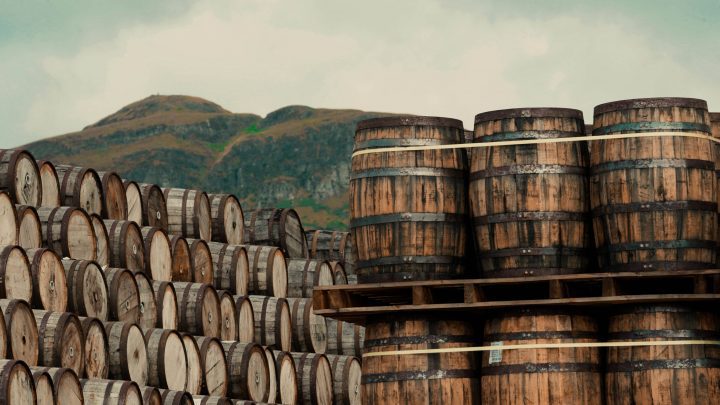
What is Cask Strength Whiskey? A Primer on How Cask Whiskey Differs from Standard Bottled Whiskey
What is Cask Strength Whiskey? A Primer on How Cask Whiskey Differs from Standard Bottled Whiskey
Over the last few years, cask strength whiskey has become something of a buzzword among aficionados. Always looking for new ways to enjoy their spirit of choice, cask strength whiskey is a way to experience a side of whiskey rarely enjoyed by the public – that is, at the exact proof at which it exists the barrel.
When distillers bottle whiskey to be sold to the public, they’re generally focusing on consistency. The flavour of a large batch won’t often vary from bottle to bottle – they tend to hit shelves at or just above the legal minimum of 40% alcohol by volume. When whiskey sits in the cask, however, it’s generally closer to 50-75% ABV.
Why this approximate percentage range every time? It comes down to the distillation process of whiskey, which is a process of concentrating the alcohol content. It’s also a legal compliance issue as when whiskey is reduced to bottling strength, legal compliance means that it must come in at around this percentage level.
And that’s a good thing for enthusiasts, too. Whiskey connoisseurs want the regulatory standards to be met, of course, from a quality control and safety perspective. But actually, also, at this lower ABV, their whiskey tastes more palatable and smoother, however, to arrive at that lower ABV “bottling strength,” whiskey distillers will then generally use pure native spring water to dilute the spirit. Distillers are very careful and cautious at this juncture because the choice of water is crucial to the whiskey’s overall and final taste.
It comes down to the specific mineral content in the water they use, different minerals in different types of spring water used, as you can imagine, alters and influences the final flavour of the whiskey you’ll sip. This water-adding process will also contribute to evening out the flavour across large batches. In brief, it helps achieve consistency in taste.
For distilleries, this is vital – to maintain that consistent product identity (to use a corporate term) that whiskey enthusiasts flock to when choosing their favourite whiskey brands.
But it gets better, even, as the whiskey transitions from cask to bottle. This process of dilution can also unlock new flavours and aromas in the whiskey, which enhances the complexity of the whiskeys we drink. This is due to that altering of the whiskey’s profile, as the whiskey’s compounds, such as its esters, alter as the water is added.
Interestingly, this is why distillers tend to adapt and adjust the amount of water they add to their whiskeys based on the differing preferences of different geographic markets and varying consumer tastes. In other words, at the inception stage of whiskey, in its early cask phase, cask strength whiskey is a portrait of the whiskey precisely as it emerged from the cask, when it was deemed mature – before the dilution process described above was pursued.
Equally, though generally higher proof than a standard whiskeys, cask whiskey is by no means lower quality or a younger product.
Quite the contrary.
Distillers can also use their fully mature whiskey for bottles, and this cask whiskey will then fill fewer bottles than they would were the distillers to dilute the spirit before bottling, as is often done for “bottling strength” whiskey.
Bottles of cask strength whiskey, then, are often considered to be more premium products than normal “bottle strength” whiskey, and offerings that can offer an exclusive taste of the distiller’s first impressions of the mature cask.
With cask strength whiskey, you’re getting an unadulterated tasting experience, that said, higher proof whiskey doesn’t automatically imply that the whiskey you’re drinking is “high quality” – in spite of this being a common perception.
It’s a more intense experience, yes – and one which some enthusiasts prefer.
But often, quality is a subjective thing.
Some people might think it’s too powerful and prefer bottled strength’s smoother taste. Ultimately, therefore, it’s a ‘horses for courses’ scenario, but as an individual experience, drinking cask whiskey is not one to be overlooked.
How to Drink Cask Strength Whiskey
“Quelle surprise,” drinking cask strength whiskey is not for the uninitiated. The flavour tends to be stronger than that of conventional whiskeys, of course, and the higher ABV will give it more donkey-kick assertiveness. Yet these characteristics are precisely why it holds such an appeal to so many.That strong flavour speaks to the relationship between the whiskey and its cask and emphasises tasting notes perhaps only hinted at in its watered down counterparts.
When drinking cask whiskey, one becomes intimately aware of each step of the whiskey maturation process; the impact of every facet of the whiskey’s surroundings on the finished product. For example, the type of cask that the distiller used (say, American oak, perhaps, or European oak) will have significantly influences the whiskey’s flavour.
At the same time, how the cask was used previously, such as in the past having housed bourbon, or cheery, or port) will also affect the whiskey’s taste (often, in delicious and delightful ways), which then has the added bonier of tweaking the complexity and depth of the whiskey you’re ultimately tasting.
And then – of course! – there’s the location of where the casks were matured, and how that plays into the whiskey’s taste. Warehouse type, climate, the casks proximity to the sea all impact the whiskey’s flavour profile.
And as you’d expect warmer climates accelerate ageing, while casks matured in cooler climates slow the maturation process down. Fluctuation in temperature and humidity throughout the year also allow the whiskey in the cask to expand and retract from the wood, which then enhances the extraction of flavours.
Enjoying cask whiskey neat, then, is the closest you’ll get to the singular joy of sampling directly from the whiskey distiller’s barrel.
We recommend trying it this way first.
What you’re able to taste may surprise you, and you may discover an affinity for tasting notes you hadn’t previously perceived. Once you’ve gotten a feel for the cask strength whiskey, you may want to try adding a few drops of water. This will open up the whiskey, and allow flavours to mellow out, develop in the glass, or become more prominent.
This is your chance to play whiskey distiller; to experiment with the ratios and discover what you like best. Though we’re generally for drinking our whiskey neat, some say cask strength whiskey can be a great addition to cocktails.
If you’re making a julep or a smash that uses plenty of ice, cask strength whiskey can round out the flavours and keep them focused as melting ice dilutes the spirit.
As with any great whiskey cocktail, keep the flavours simple and the emphasis on your cask strength whiskey.
Cask Whiskey Investments with Whiskey & Wealth Club
Whatever strength whiskey you enjoy, its unique flavour is the result of high-quality casks, the local environment, patience, and no small effort on part of master distillers. At the Whiskey & Wealth Club, we celebrate every part of this process by offering clients the opportunity to purchase branded whiskey casks from exceptional distilleries.We invite any prospective clients to tour the whiskey distilleries with us.
Get a feel for the places that produce these incredible spirits, learn more about the distillers, and ask us (and your fellow investors) any questions you may have.
Who knows, you may even get a taste of that cask strength whiskey – straight from the barrel?
Check out the Whiskey Wealth Club reviews and if you’re interested in taking part in one of our tours or just asking our experts a few questions about whiskey cask investment, get in touch today.

